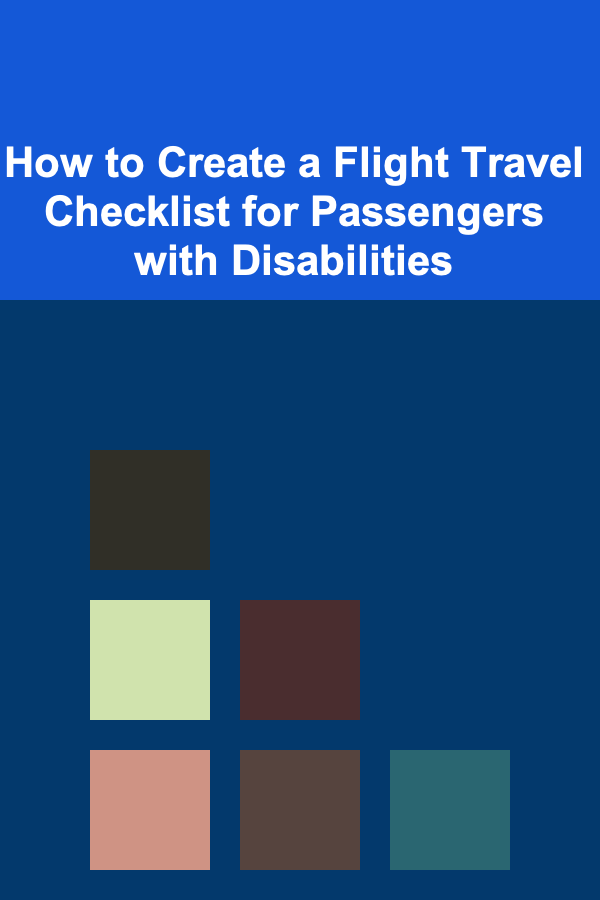
How to Create a Flight Travel Checklist for Passengers with Disabilities
ebook include PDF & Audio bundle (Micro Guide)
$12.99$8.99
Limited Time Offer! Order within the next:

Traveling by air can be a challenging experience for everyone, but for passengers with disabilities, it can present unique obstacles. From booking a flight to navigating the airport, boarding the aircraft, and managing in-flight needs, there are many factors to consider. However, with thoughtful preparation and an effective checklist, air travel can be made more accessible and less stressful.
This article aims to provide a comprehensive guide on creating a flight travel checklist for passengers with disabilities. Whether it's your first time traveling with a disability or you're a seasoned traveler, this guide will help ensure that you have all the information and tools needed for a smooth journey. We'll cover essential aspects such as planning, booking, documentation, navigating the airport, in-flight comfort, and arriving at your destination.
Why a Flight Travel Checklist is Important for Passengers with Disabilities
For passengers with disabilities, travel can involve additional planning and support. Disabilities vary widely in terms of needs and requirements, so it's important to have a customized checklist to address personal needs. A flight travel checklist serves as a roadmap, reducing the likelihood of forgetting critical items or steps that may otherwise cause unnecessary stress.
A well-thought-out checklist can help in the following ways:
- Ensuring Safety: Addressing medical needs, equipment, and emergency procedures.
- Reducing Anxiety: By knowing exactly what steps to take, passengers with disabilities can reduce the stress associated with air travel.
- Ensuring Accessibility: Identifying accessible services at every stage, from the airport to the flight itself.
- Maximizing Comfort: Ensuring the passenger is comfortable throughout the journey with suitable accommodations.
Preparation Before Booking the Flight
2.1 Identifying Specific Travel Needs
Before even selecting a flight, it is crucial to identify the passenger's specific needs based on the type of disability. This might include physical, sensory, cognitive, or mental health conditions. Some disabilities require special equipment (e.g., mobility aids), while others may need assistance with communication or medical care during the flight.
2.2 Researching Airlines with Disability Services
Different airlines have varying levels of support for passengers with disabilities. It's important to choose an airline that offers services specifically tailored to accessibility needs. Research and compare:
- Wheelchair Services: Most airlines provide free wheelchair assistance to passengers with mobility challenges. Some airlines even allow you to pre-board the plane for extra time to get situated.
- Special Seating Arrangements: Request seating that suits your needs (e.g., aisle seats for ease of access, or seats with extra space for wheelchairs).
- Assistance with Boarding and Deplaning: Some airlines offer specialized assistance for boarding and deplaning, including priority boarding, ramps, and dedicated staff.
- Medical Oxygen or Other Equipment: For passengers with respiratory issues, airlines must be informed in advance to arrange medical oxygen services.
2.3 Confirming Disability Accommodations
It is essential to confirm all necessary accommodations well in advance of the flight. Contact the airline to make specific requests, such as:
- Wheelchair assistance at the gate and throughout the airport.
- Support for passengers who are deaf or hard of hearing (e.g., sign language interpreters or visual cues).
- Special meals for dietary requirements related to a disability.
- Assistance for passengers with cognitive or mental health disabilities, such as help with navigation or support with anxiety.
2.4 Booking the Right Flight Time
Passengers with disabilities may have unique energy levels and medical needs that require careful consideration when choosing flight times. Look for:
- Non-stop Flights: Minimizing the number of layovers reduces the potential for confusion and stress.
- Optimal Flight Times: If the passenger has a disability that causes fatigue or requires medication, it's important to book a flight during a time that works with their natural rhythm.
Essential Documentation and Paperwork
3.1 Medical Documentation
Many airlines require documentation to verify the need for specific accommodations, especially if the disability affects mobility or medical needs. This might include:
- A letter from a doctor explaining the medical condition and any accommodations needed.
- A prescription for any medical devices or medication being brought onboard.
- Documentation regarding any special equipment, such as oxygen tanks or CPAP machines.
3.2 Disability Identification Cards
Some passengers may have a disability identification card or a disability travel card, which can help identify needs and expedite the process of receiving assistance at airports and on the aircraft.
3.3 Contact Information for Assistance
Keep a list of relevant contacts:
- Airline customer service for assistance before, during, and after the flight.
- Medical contacts, if necessary, for managing health-related issues during the flight.
- Family or friends who will be accompanying the traveler and may need to assist during the journey.
Pre-Flight Checklist: Airport Preparation
4.1 Arriving Early
It's advisable for passengers with disabilities to arrive at the airport at least 2-3 hours before departure. This extra time helps to ensure all necessary arrangements are made and provides a buffer in case of any delays.
4.2 Checking In
During check-in, notify the airline staff about your disability and any specific needs you have. Request:
- Assistance at the check-in desk.
- Priority boarding.
- Special seating arrangements.
- Extra space for medical equipment, if applicable.
4.3 Security Screening
Security screening can be one of the most stressful parts of air travel, especially for passengers with disabilities. Here's how to prepare:
- Know the Rules: Some items, such as mobility aids, oxygen tanks, or medications, may require special handling or approval. Check with the TSA or airport security about specific rules.
- Notify Security Personnel: When you reach security, let the personnel know about your disability and any special equipment or medical conditions. Many airports provide a "disability lane" to expedite screening.
- Consider Screening Alternatives: In some cases, passengers with disabilities can request an alternative screening process to avoid discomfort or injury.
4.4 Arranging Assistance Through the Airport
Once through security, it's essential to coordinate assistance to get to the departure gate. This might involve:
- Wheelchair assistance from security to the gate.
- Assistance navigating the airport for passengers with cognitive impairments or those who experience anxiety in crowded areas.
- Notifications for any special needs in case of flight delays or cancellations.
In-Flight Comfort and Safety
5.1 Seat Considerations
Choose the best seat based on comfort and accessibility:
- Aisle Seats: These seats are essential for those who need easy access to the bathroom or other areas during the flight.
- Bulkhead Seats: These seats offer more space and can be a good choice for passengers with mobility aids or who need extra room for comfort.
- Requesting Extra Space: If needed, passengers can request more space for wheelchairs or other medical devices.
5.2 Medical Equipment and Medications
Ensure that any medical equipment or medications are properly packed and easily accessible. Remember to:
- Carry a sufficient supply of medications for the duration of the flight, including any prescriptions or over-the-counter medications that might be needed.
- Keep medical equipment, such as a portable oxygen concentrator or CPAP machine, within reach. Ensure that all devices comply with airline regulations.
5.3 Communication Needs
For passengers with hearing or speech impairments, consider ways to facilitate communication:
- Sign Language: Some airlines offer sign language interpreters upon request. Make sure to notify the airline well in advance.
- Assistive Technology: Apps and devices that help communicate more effectively may be necessary for some passengers.
5.4 Managing In-Flight Services
If the passenger has any specific needs during the flight, such as extra assistance with meals, using the restroom, or managing stress, make these arrangements ahead of time with the flight attendants. For example:
- Requesting special dietary meals.
- Ensuring that flight attendants are aware of any mobility assistance requirements.
- Asking for extra time when disembarking, especially for passengers with mobility challenges.
Post-Flight Checklist: Arrival and Deplaning
6.1 Arriving at the Destination
Upon arrival at the destination, passengers with disabilities should notify the airline staff for assistance with deplaning and navigating the airport. Ensure that:
- Wheelchair assistance is available.
- Any necessary medical equipment is returned safely.
- The passenger's luggage and belongings are retrieved.
6.2 Arranging Ground Transportation
Once you've cleared customs and baggage claim, arrange accessible transportation from the airport. This might include:
- Wheelchair-accessible taxis or ride-sharing services.
- Public transportation options with accessible features.
- Special arrangements with a hotel or family for any additional assistance needed.
Additional Tips for a Smooth Flight Experience
- Stay Organized: Keep all documentation, including medical records and flight details, in a convenient and accessible place.
- Stay Informed: Monitor flight status for delays or gate changes, and be prepared for unexpected situations.
- Consider Travel Insurance: For extra peace of mind, consider purchasing travel insurance that covers medical needs or flight cancellations.
Conclusion
Traveling by air doesn't have to be a stressful experience for passengers with disabilities. With thoughtful planning, communication, and the use of a flight travel checklist, passengers can enjoy a smoother, more comfortable journey. From booking the flight to ensuring in-flight comfort and managing post-flight logistics, every step can be simplified by taking the time to prepare in advance.
By creating a personalized checklist that considers the unique needs of the passenger, you can help ensure a safe, enjoyable, and stress-free travel experience.
Reading More From Our Other Websites
- [Home Holiday Decoration 101] How to Decorate Your Home for Hanukkah
- [Organization Tip 101] How to Create a Minimalist Storage Solution
- [Organization Tip 101] Chimney Cap Replacement vs. Repair: What You Need to Know
- [Hiking with Kids Tip 101] Family-Friendly Sunset Hikes: Top Trails That Kids Will Love
- [Organization Tip 101] How to Declutter Your Bookshelf Without Regret
- [Home Staging 101] How to DIY Home Staging Tips for a Budget-Friendly Makeover
- [Home Storage Solution 101] How to Organize Your Garage for Maximum Storage Efficiency
- [Home Lighting 101] How to Use Lighting to Add Drama to Your Home's Decor
- [Personal Care Tips 101] How to Use Dry Shampoo to Help Your Hair Maintain a Clean and Fresh Look Longer
- [Organization Tip 101] How to Store Seasonal Sports Equipment Neatly

How to Stage Each Room for Maximum Appeal
Read More
How To Grow Fresh Mushrooms at Home
Read More
How to Boil Pasta Al Dente Every Time
Read More
Understanding Gen Z on Social Media: A Deep Dive
Read More
How to Overcome Emotional Eating Habits
Read More
How to Ferment Mushrooms: A Guide to Delicious and Healthy Delights
Read MoreOther Products

How to Stage Each Room for Maximum Appeal
Read More
How To Grow Fresh Mushrooms at Home
Read More
How to Boil Pasta Al Dente Every Time
Read More
Understanding Gen Z on Social Media: A Deep Dive
Read More
How to Overcome Emotional Eating Habits
Read More